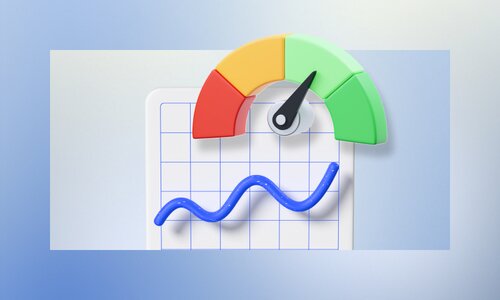Your credit score paints a picture of your financial health for potential lenders and employers, impacting everything from loan interest rates to getting approved for an apartment rental. One of the most important but misunderstood aspects of determining your credit score is the credit utilization ratio.
Understanding credit utilization is an integral part of managing your credit history. Here’s what you need to know:
What is credit utilization?
The credit utilization ratio refers to the amount of credit a borrower uses compared to their available credit limit, expressed as a percentage.
For example, if you have three credit cards, each with a limit of $5,000, and you have a balance of $3,000 on one, $2,500 on another, and $2,000 on the third, you’re using $7,500 of your available $15,000, and your credit utilization is 50%.
A higher credit utilization ratio indicates you’re using much of your available credit. If your credit utilization ratio is too high, it can negatively impact your credit score.
Credit scoring models give credit utilization rate a lot of weight — as much as 30% — when determining your credit score.
How credit utilization works
Credit utilization rates are based entirely on revolving credit. Revolving credit accounts refer to lines of credit that do not have a pre-defined payment structure or end date. Credit cards and open lines of credit because you can borrow a different amount each month, and the balances roll over to the next month. Home equity lines of credit (HELOCs) also fall within this category.
These differ from installment loans, such as student loans, auto loans, or mortgages, where you borrow a set amount of money and then pay it off over months or years in a fixed monthly installment. Creditors also look at your utilization of these loans, but they use a different metric — the debt-to-income ratio or DTI.
How to calculate your credit utilization rate
The credit utilization rate formula is straightforward:
- Make a list of all your credit cards and open lines of credit.
- Add up the balance of your total credit card debt.
- Calculate your overall credit limit across all cards.
- Divide your balance by the total credit limit.
- Multiply this number by 100.
To calculate the credit card utilization rate for each card, you’ll follow the same process, but instead of using totals, simply use the individual credit card limit and balance.
What is a good credit utilization rate?
Most personal finance experts suggest 30% as a good credit utilization ratio. This shows potential lenders that you’re using available debt responsibly and aren’t stretched beyond your means. A higher percentage signals the opposite and can lead to you being charged higher interest rates and not qualifying for certain loans.
There is a caveat to this, however: Lower is always better. A 2016 study by FICO found that consumers with the best credit scores of 750 and above use less than 10% of their total available credit limit. While many factors affect a credit score, keeping utilization low helps.
Per-card vs. total utilization
While credit scoring models typically look at your overall credit utilization, a high credit utilization on one card can also factor in.
For example, as with our previous example, let’s say you have three credit cards, each with a limit of $5,000. Now, if you carry a balance of $2,000 on one, $1,000 on another, and $4,500 on the third, your total balance is $7,500 with a 50% overall credit utilization. That’s still high, but what’s concerning in this example is that your credit utilization is 90% on that third credit card, which could ding your credit score.
It’s essential to ensure your per-card utilization is below the recommended limit.
How your credit utilization affects your credit score
The FICO scoring model, used by most lenders, uses several pieces of credit data in your credit report grouped into five categories:
1. Payment history (35%)
Since your credit score is a risk assessment score, a history of missed or late payments can be a red flag for a potential lender and says to them that you can’t always be relied upon to foot the monthly bill.
2. Amounts owed or credit utilization (30%)
Credit utilization is the second most important piece that makes up your credit score. If you’re overextended on debt, it signals to a lender that you may have trouble repaying the loan.
3. Length of credit history (15%)
The FICO score considers how long you’ve had all your credit accounts, how long certain accounts have been active, and how long it’s been since you used them.
4. Credit mix (10%)
Credit mix represents the types of credit and lending accounts on your credit history.
5. New credit (10%)
If you’ve opened too many new accounts quickly, this is a red flag for lenders and signals that you may have cash flow problems.
How to lower your credit utilization rate
You can take steps to reduce your credit utilization.
1. Pay off more debt
This is the most obvious solution but also, for many people, the most difficult. By making an extra credit card payment in each billing cycle, you may start seeing a low credit utilization ratio because of the reduced debt since consumer reporting agencies such as Equifax, Transunion, and Experian will only report activity on your credit card account once per month.
2. Spread your charges across multiple cards
If you’re using one credit card over others, you may have low overall utilization but still, be penalized for over-utilization on that one card. The simple trick is to spread your expenses over multiple cards so none of them exceed 30% utilization.
3. Request a credit limit increase
If you qualify and have a good credit score, ask your credit card issuer for a credit limit increase. Of course, you don’t plan to use it, but this higher credit limit will help lower your credit utilization ratio. Applying for a new credit card or a balance transfer card can also be beneficial. Be warned, however. Each action results in a hard credit inquiry, so your credit score may temporarily dip.
The bottom line
There are many smart things you can do to secure your financial future, and one of them is to understand how your credit utilization impacts your credit score and what you can do to turn it into an advantage. By managing your credit smartly, you ensure that you’re never overextended beyond your means and that the next loan you apply for comes with favorable terms and lower interest rates.
If you’re looking for an investment vehicle that will grow your money in the long term while also giving you short-term cash flow, Arrived can help. At Arrived, our mission is to provide financial freedom for everybody, and we do this by allowing you to purchase shares in profitable rental properties.
The opinions expressed in this article are for general informational purposes only and are not intended to provide specific advice or recommendations for any individual or on any specific security or investment product. The views reflected in the commentary are subject to change at any time without notice. View Arrived’s disclaimers.








